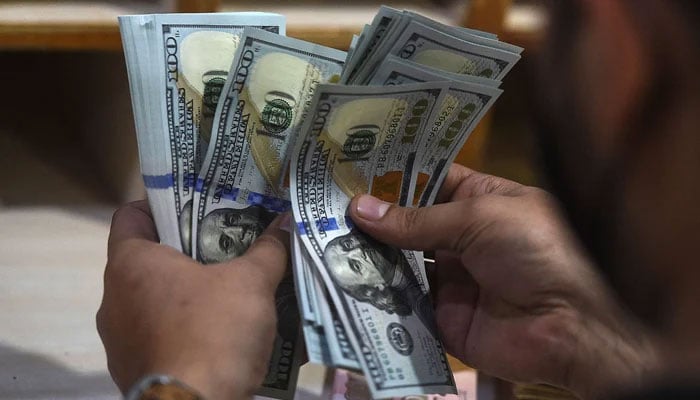SBP reserves plummet to nine-year low of $3.1bn
The current reserves can barely cover two to three weeks’ worth of imports.
KARACHI: The central bank’s foreign exchange reserves have hit a nine-year low of $3.1 billion as of January 27, making it extremely difficult for the cash-strapped country to finance imports.
The reserves can barely cover two to three weeks’ worth of imports due to a lack of US dollars.
The country has $8.7 billion in reserves in total, including $5.7 billion held by commercial banks.
In a statement released on Thursday, the State Bank of Pakistan said external debt repayments were to blame for a large $592 million week-over-week fall in reserves.
According to analysts, the government’s repayment of its commercial loan to China caused the reserves to decline.
The reserves, which were nearly $18 billion at the beginning of 2022 but have since experienced significant depletion, highlight Pakistan’s urgent need to secure financing from the International Monetary Fund.
An IMF delegation arrived in Pakistan on Tuesday and is scheduled to remain here until February 9 to resume negotiations for $6.5 billion loan programme that has been on hold since November. As thousands of cargo containers build up at ports and the price of necessities like food and energy rises,
Pakistan has been experiencing a full-blown economic turmoil. The balance of payments situation gets worse when reserves deplete. The nation is also battling escalating prices. The SBP increased its benchmark interest rate to 17 percent in an effort to combat consumer inflation.
After the government relaxed currency controls to comply with one of the loan requirements set forth by the IMF, the rupee has been losing value versus the US dollar. Pakistan’s currency fell 0.93 percent, or 2.53 rupees, setting a new record low on Thursday. The rupee ended at 271.36 per dollar, weaker than the previous close of 268.83 in the interbank market. The IMF negotiations are going on, and it appears that there are disagreements on every issue on the agenda. In contrast to the Rs300 billion that the government has suggested, the IMF wants more taxes.
Circular debt management plan has also been rejected by the IMF, which wants higher gas and electricity prices than those suggested by the government.
The differences between the government and the IMF have undermined market confidence in the currency and raised concerns about the prospect of a snag in the continuing negotiations between the two sides. This can delay the disbursement of the next IMF loan tranche, according to analysts.
“The demand is higher, as a lot of imports have piled up,” said Samiullah Tariq, the head of research at Pak-Kuwait Investment Company.
“The IMF negotiations are on their way. No uncertainty until now. As the currency is market-determined, any day in which demand is greater than supply, the parity moves higher,” Tariq added. Scarcity of dollars, according to Fahad Rauf, head of research at Ismail Iqbal Securities, is what is exerting pressure on the rupee.
“The banks have been running short open positions, so there is a demand for dollars. The inflow has to be large enough to tame the rate. This is why we need flows to stabilise the dollar,” Rauf said.
-
 Philippines Blocks Elon Musk’s Grok AI
Philippines Blocks Elon Musk’s Grok AI -
 Jennifer Lawrence Blames Internet For Losing Sharon Tate Role
Jennifer Lawrence Blames Internet For Losing Sharon Tate Role -
 DeepMind, Google CEOs Sync Daily To Accelerate AI Race Against OpenAI
DeepMind, Google CEOs Sync Daily To Accelerate AI Race Against OpenAI -
 Japan Launches Probe Into 'Grok AI' Following Global Scrutiny Over 'inappropriate' Content
Japan Launches Probe Into 'Grok AI' Following Global Scrutiny Over 'inappropriate' Content -
 Prince Harry All Set To Return To Britain Next Week?
Prince Harry All Set To Return To Britain Next Week? -
 Is Princess Charlotte Becoming Most Confident Young Royal?
Is Princess Charlotte Becoming Most Confident Young Royal? -
 ‘Stranger Things’ Star David Harbour Speaks Up About ‘psychotherapy’
‘Stranger Things’ Star David Harbour Speaks Up About ‘psychotherapy’ -
 Jennifer Love Hewitt Talks About Scary 9-1-1 Episode
Jennifer Love Hewitt Talks About Scary 9-1-1 Episode -
 Kate Middleton Ditches Palace Life For Where She 'truly Relaxes'
Kate Middleton Ditches Palace Life For Where She 'truly Relaxes' -
 Pixel Watch May Soon Warn You If You Leave It Behind
Pixel Watch May Soon Warn You If You Leave It Behind -
 Serious Liver Scarring Shows Potential To Be Reversed With Latest Drug
Serious Liver Scarring Shows Potential To Be Reversed With Latest Drug -
 Elon Musk Backs Donald Trump To Invoke Insurrection Act Amid Minnesota Protests
Elon Musk Backs Donald Trump To Invoke Insurrection Act Amid Minnesota Protests -
 Scientists Unravel Mystery Of James Webb’s ‘little Red Dots’ In Deep Space
Scientists Unravel Mystery Of James Webb’s ‘little Red Dots’ In Deep Space -
 Nano Banana Explained: How Google’s AI Got Its Name
Nano Banana Explained: How Google’s AI Got Its Name -
 Fire Causes Power Outage On Tokyo Train Lines, Thousands Stranded As ‘operations Halted’
Fire Causes Power Outage On Tokyo Train Lines, Thousands Stranded As ‘operations Halted’ -
 YouTube, BBC To Ink Landmark Deal To Launch Exclusive Bespoke Shows
YouTube, BBC To Ink Landmark Deal To Launch Exclusive Bespoke Shows




